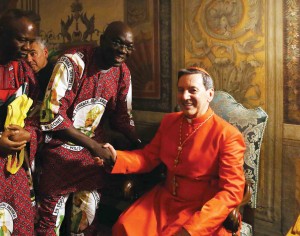On November 24, Benedict XVI appointed six new cardinals from the US, Lebanon, Philippines, Nigeria, Colombia and India, in a ceremony in St. Peter’s Basilica.

Nigerian Archbishop John Olorunfemi Onaiyekan, 68, of Abuja, receives the red biretta from Benedict XVI

U.S. Archbishop James M. Harvey, 63, former prefect of the papal household, speaks with Lebanon’s Maronite Patriarch Bechara Rai, 72.
Recalling that Christ’s mission transcends “all ethnic, national and religious particularities,” Pope Benedict XVI on November 24 created six new cardinals from four different continents, representing the Latin rite of the Catholic Church as well as two Eastern Catholic Churches.
The churchmen who joined the College of Cardinals were US Archbishop James M. Harvey, 63, former prefect of the papal household; Lebanon’s Maronite Patriarch Bechara Rai, 72; Indian Archbishop Baselio Cleemis Thottunkal, 53, head of the Syro-Malankara Catholic Church; Nigerian Archbishop John Olorunfemi Onaiyekan, 68, of Abuja; Colombian Archbishop Ruben Salazar Gomez, 70, of Bogota; and Philippine Archbishop Luis Tagle, 55, of Manila.
“I want to highlight in particular the fact that the Church is the Church of all peoples, so she speaks in the various cultures of the different continents,” the Pope said during the hour-long service in St. Peter’s Basilica. “Amid the polyphony of the various voices, she raises a single harmonious song to the living God.”
The six new cardinals later stepped up to the Pope, who was seated before the basilica’s main altar, to receive symbols of their office: a ring, the zucchetto skull cap and the three-cornered hat called a biretta. The headwear was colored scarlet, like the cardinals’ robes, to symbolize the blood they risk shedding in service to the Church.

Colombian Archbishop Ruben Salazar Gomez, 70, of Bogota;
The new Eastern Catholic cardinals received modified versions of the biretta, consistent with the distinctive clerical garb of their churches. Cardinal Rai received the turban-like Maronite tabieh, and Cardinal Cleemis a head covering in a shape reminiscent of an onion dome.
Pope Benedict also assigned each of the new cardinals a “titular church” in Rome, making them full members of the Rome clergy and closer collaborators of the Pope in governing the universal Church.
Cardinal Harvey’s titular church is the Church of Saint Pius V a Villa Carpegna, a post-war church about a mile southwest of Vatican City. The Pope has also named Cardinal Harvey to serve as archpriest of the Basilica of St. Paul’s Outside the Walls, one of Rome’s four major papal basilicas.

Indian Archbishop Baselio Cleemis Thottunkal, 53, head of the Syro-Malankara Catholic Church, greets Wlodzimierz Redzioch, Inside the Vatican journalist.
The November 24 ceremony was a much quieter affair than the last consistory in February, when Pope Benedict created 22 cardinals, including three from the United States and Canada. This time, there was no overflow crowd in St. Peter’s Square, and only 99 of the 211 members of the College of Cardinals were in attendance.
Yet the congregation was spirited, with pilgrims applauding enthusiastically as the new cardinals’ names were called. Cardinal Tagle seemed especially moved as he knelt before the Pope, and afterwards was seen wiping a tear from his eye.
At the end of the ceremony, the College of Cardinals had 211 members, 120 of whom were under the age of 80 and thus eligible to vote in a conclave to elect a new Pope.
The new consistory raises the percentage of Asian electors from 7 percent to 9 percent. Catholics in Asia account for just over 10 percent of the worldwide Catholic population.

Philippine Archbishop Luis Tagle, 55, of Manila
At the same time, the percentage of European electors dropped slightly, to just over 51 percent. But the continent remains statistically overrepresented, since the Vatican reports that fewer than 24 percent of the world’s Catholics live in Europe.






Facebook Comments